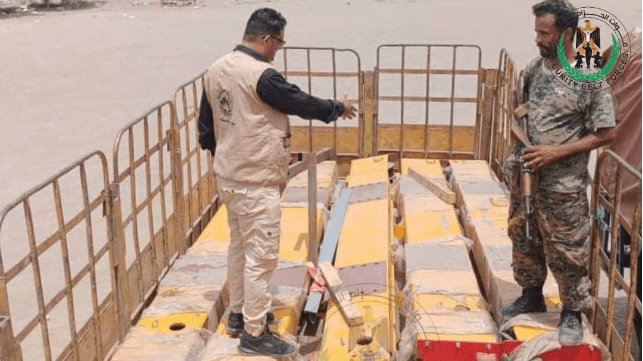Houthi Forces Are Importing Drone Parts and Supplies From China

Houthi forces in Yemen appear determined to maintain their campaign against shipping interests with claimed links to Israeli port calls. They also spasmodically and ineffectively continue to fire drones and missiles at Israel. However, recent attacks on port infrastructure in Hodeidah, Ras Isa and Salif have complicated the importation of the materials the Houthis need to pursue their campaign.
Security Belt forces in Lahj, sponsored by the United Arab Emirates, recently intercepted a cargo of prefabricated cranes manufactured in China at a border crossing point at Al Hawtah. The hoists would have been used to unload ship containers, replacing infrastructure destroyed on the attacks on Houthi ports. The prefabricated cranes had been unloaded in Aden, and the Houthis had been attempting to smuggle the components by truck into Houthi-controlled areas. The interception took place at a control point between the two contested areas of Yemen. Further south in Abyan, Security Belt Forces also recently intercepted a large quantity of small arms ammunition which was also being smuggled northwards in a truck; such interceptions are commonplace.
Another recent cargo seizure comprised the equipment necessary to build a drone factory in the Houthi-controlled area. The equipment was intercepted on August 2 by the Counter-Terrorism Service in Aden, and had been packed into five containers declared to be holding car parts which had been unloaded from a ship arriving directly from China. Analysis of the equipment within the containers suggests that the drones which the factory, once assembled, could have manufactured would have been of short to medium range.
Intercepted in another cargo was a Swiwin SW1200Pro turbojet, manufactured in the Baoding High-Tech Zone in China. The thrust output of such a turbojet also would be suitable for short to medium range drones. However, for longer-range drones and missiles, the Houthis still seem to be reliant on components imported from Iran; the dhow Al Sharwa intercepted in July by Tareq Saleh’s National Resistance Forces contained Iranian-manufactured components for the longer range Sayyad cruise missile, which has a 200-kilo warhead and a 500-mile range.
The Chinese maintain good relations with the internationally-recognized Yemeni government, with an embassy based in Aden. When interviewed by Asharq Al-Awsat on July 8, Chargé d'Affaires Shao Zheng claimed that China maintains strict controls over goods which could be of military value to the Houthis. Predictably, on August 12 he described as "baseless rumors" the reports that Chinese goods had been intercepted in the port, and said that he did not know where the Chinese-manufactured turbojets had come from.
Overland smuggling keeps supplies flowing
Traffic flows constantly across land borders between the two contested areas of Yemen, a reality exploited by Iranian arms smuggling networks. Controls are not always effective and can be circumvented with bribery. The main road from Aden, controlled by the internationally-recognized government, has recently been re-opened, and from Taiz passes through Houthi-controlled areas to Sana’a and Hodeidah. Now that use of Red Sea ports has been impeded, use of these internal smuggling routes through Yemen is likely to increase.

that matters most
Get the latest maritime news delivered to your inbox daily.
Increased seizures, both at sea and internally within Yemen, indicate that if the well-established “front door” smuggling routes from Iran through Hodeidah are disrupted, then the Houthis will adapt and use “back door” routes instead. The Houthis are unlikely to be able to self-manufacture all that they need to pursue their aggressive campaign. This then places additional responsibilities on shipping and logistic companies to ensure that customs and end-user declarations are accurate.
The Houthi movement is at present undergoing some internal disruptions, but pursuit of hostile acts against demonized external parties is one mechanism which the Houthis probably believe can unite their movement. So adaptive arms smuggling is going to continue, and Chinese firms will be delighted to take advantage of the commercial opportunities presented, with or without the knowledge or encouragement of the Chinese authorities.
